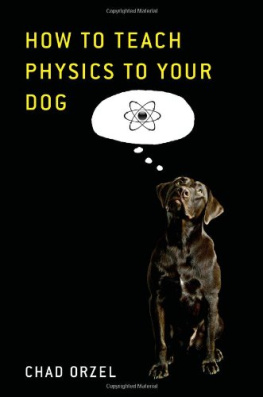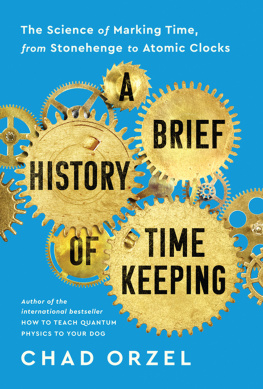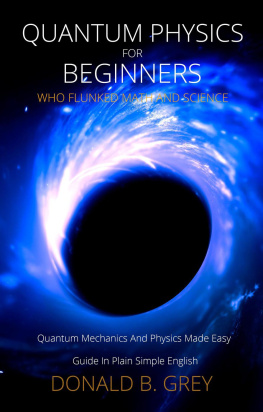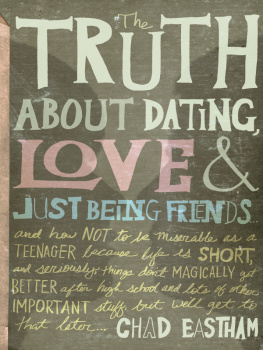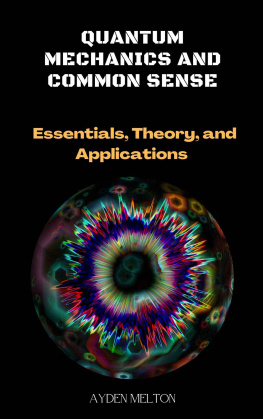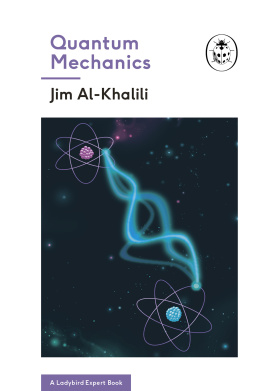ACKNOWLEDGMENTS
I learned about the physics described in this book from a large number of mentors and colleagues over a period of almost twenty years. Many thanks are due to Bill Phillips, Steve Rolston, Paul Lett, Kris Helmerson, Ivan Deutsch, Aephraim Steinberg, Luis Orozco, Paul Kwiat, Mark Kasevich, Dave DeMille, Seyffie Maleki, Kevin Jones, Jeff Strait, Stuart Crampton, and Bill Wootters. All the good parts of the explanations are ultimately due to them; any mistakes are original to me.
I got many helpful comments on an early draft of this book from my intrepid beta readers: Jane Acheson, Lisa Bao, Aaron Bergman, Sean Carroll, Yoon Ha Lee, Matt McIrvin, and Frances Moffet. Michael Nielsen and David Kaiser also made helpful comments on draft copies. All of them helped make this a better book than it wouldve been otherwise.
This book grew out of a couple of posts on my weblog, Uncertain Principles (http://scienceblogs.com/principles/), which eventually became the opening dialogues of chapters 4 and 9. Thanks are due to the folks at ScienceBlogsChristopher Mims, Katherine Sharpe, Erin Johnson, and Arikia Millikanfor providing me with a platform, and to Cory Doctorow of Boing Boing and the people at Digg for promoting those posts. Barrett Garese, Erin Hosier, and Patrick Nielsen Hayden deserve thanks for convincing me that writing a physics book with my dog was a good idea. And of course, thanks to my editor, Beth Wareham, and agent, Erin Hosier, for all their help getting the book into shape, and helping me navigate the publishing process, which is completely different than anything in physics.
Emmy was adopted from the Mohawk & Hudson River Humane Society shelter in Menands, New York (http://www.mohawkhumanesociety.org/). Like most animal shelters, they are an excellent source of wonderful dogs (and other pets), and I would encourage anyone thinking of getting a dog to look at their local shelter.
Ive been lucky enough to know a lot of dogs over the yearsPatches, Rory, Truman, the late great RD, Bodie, and even Tinkerand theres a little bit of all of them in this book. Most of the credit goes to Emmy, though, who is unquestionably the best Emmy ever, and the Queen of Niskayuna.
Many thanks are due to my friends and family, who have been tremendously supportive despite finding the whole thing a little weird. And last, but far from least, thanks to my wife, Kate Nepveu, for reading innumerable drafts and gently correcting my grammar; for patiently listening to me rant and kick ideas around; and for baby Claire, who complicated things in the best way possible, and most of all for inspiring the whole thing by laughing when I have silly conversations with the dog. This quite literally would not have happened without her.
Further Reading
David Lindleys Uncertainty: Einstein, Heisenberg, Bohr, and the Struggle for the Soul of Science (Doubleday, 2007) provides a very readable introduction to the early history of quantum theory, as well as a detailed account of the debates about the theory and the meaning of the uncertainty principle.
Louisa Gilders The Age of Entanglement: When Quantum Physics Was Reborn (Knopf, 2008) covers some of the same territory as Uncertainty, but with more of an emphasis on entanglement, and goes on to describe Bohms nonlocal hidden variable theory, Bells theorem, and the first experimental tests of nonlocality. The book is built around several reconstructed conversations among the important figures in the story, with dialogue pieced together from letters and memoirs.
The Tests of Time: Readings in the Development of Physical Theory, edited by Lisa M. Dolling, Arthur F. Gianelli, and Glenn N. Statile (Princeton University Press, 2003), reproduces many of the classic papers in early quantum theory, including Bohrs original model of hydrogen; the Einstein, Podolsky, and Rosen paper; Bohrs response to EPR; and John Bells famous theorem.
The Theory of Almost Everything: The Standard Model, the Unsung Triumph of Modern Physics by Robert Oerter (Plume, 2006) gives an excellent overview of the state of modern physics, including basic quantum theory, QED, and issues in particle physics that are not discussed in this book.
Richard Feynmans QED: The Strange Theory of Light and Matter (Princeton University Press, 2006) is a wonderfully accessible explanation of the details of quantum electrodynamics. His autobiographical books (Surely Youre Joking, Mr. Feynman and What Do You Care What Other People Think?) have less physics, but are great fun.
For more mathematically inclined readers, The Quantum Challenge, Second Edition: Modern Research on the Foundations of Quantum Mechanics by George Greenstein and Arthur G. Zajonc (Jones and Bartlett, 2005) gives an excellent overview of many of the experiments that have demonstrated the strange features of quantum mechanics.
James Gleicks Genius: The Life and Science of Richard Feynman includes a description of the development of QED, and the rivalry between Feynman and Julian Schwinger.
On an artistic note, Michael Frayns play Copenhagen makes powerful use of quantum ideas in exploring the famous falling-out between Niels Bohr and Werner Heisenberg.
And finally, George Gamows Mr. Tompkins stories (collected in Mr. Tompkins in Paperback [Cambridge University Press, Canto Imprint, 1993]) are the original whimsical exploration of modern physics, through the daydreams of an unassuming bank clerk. No physics book involving a talking dog could possibly fail to mention them.
CHAPTER 1
Which Way? Both Ways: Particle-Wave Duality
Were out for a walk, when the dog spots a squirrel up ahead and takes off in pursuit. The squirrel flees into a yard and dodges around a small ornamental maple. Emmy doesnt alter her course in the slightest, and just before she slams into the tree, I pull her up short.
Whatd you do that for? she asks, indignantly.
What do you mean? You were about to run into a tree, and I stopped you.
No I wasnt. She looks off after the squirrel, now safely up a bigger tree on the other side of the yard. Because of quantum.
We start walking again. Okay, youre going to have to explain that, I say.
Well, I have this plan, she says. You know how when I chase the bunnies in the backyard, when I run to the right of the pond, they go left, and get away?
Yes.
And when I run to the left of the pond, they go right, and get away?
Yes.
Well, Ive thought of a new way to run, so they cant escape.
What, through the middle of the pond? Its only about eight inches deep and a couple of feet across.
No, silly. Im going to go both ways. Ill trap the bunnies between me.
Uh-huh. Thats an... interesting theory.
Its not a theory, its quantum physics. Material particles have wave nature and can diffract around objects. If you send a beam of electrons at a barrier, theyll go around it to the left and to the right, at the same time. Shes really getting into this, and she doesnt even notice the cat sunning itself in the yard across the street. So, Ill just make use of my wave nature, and go around both sides of the pond.
And where does running headfirst into a tree come in?
Oh, well. She looks a little sheepish. I thought I would try it out on something smaller first. I got a good running start, and I was just about to go around when you stopped me.
Ah. Like I said, an interesting theory. It wont work, you know.
Youre not going to try to claim I dont have wave nature, are you? Because I do. Its in your physics books.
No, no, youve got wave nature, all right. Youve also got Buddha nature
Im an enlightened dog!
which will do you about as much good. You see, a tree is big, and your wavelength is small. At walking speed, a twenty-kilogram dog like you has a wavelength of about 10-35 meters. You need your wavelength to be comparable to the size of the treemaybe ten centimetersin order to diffract around it, and youre thirty-four orders of magnitude off.

